Note that this is part 5 of a series. In this installment I ramble on about miscellaneous gameplay features.
In this post I'll showcase a few gameplay features currently present or in progress. The screenshots are too large to fit at full size, so click them to view the full-size versions.
Dev World
Because the actual game worlds are quite large and filled with so many objects, loading them takes a while. It's not that long but when you're trying to repeatedly tweak new features you want to able to iterate quickly.
To cater for this I have a separate development world with a very basic background, containing a collection of game objects that I can enable or disable as needed. Similar scenes exist for testing game characters, abilities and gear in isolation, but 'dev world' is the one where I spend most of my time.
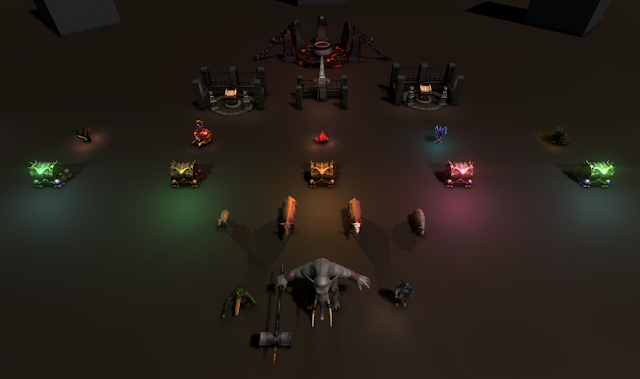 |
| This is my 'dev world'. Currently it has the potion cauldron, some lore books, the slot machine, some ingredient plants, treasures chests, livestock animals and town guards enabled. Usually I only enable whatever I'm working on at the time, but I enabled a fair bit here just to demonstrate. |
Slot Machine
Occasionally I'll lose focus and get side-tracked on some spur of the moment wild idea that doesn't really contribute to the core game. Although I kick myself for spending so much time getting side-tracked I do think that these arbitrary features end up being interesting mini-games that add character and flavor to the game.
The slot machine was one of these. I spent about 3 or 4 evenings implementing it (it took longer than initially anticipated). The slot machine allows you to spend gold for a chance of winning gear and items.
Unlike your typical slot machine game I actually modelled and simulated the individual reels, like an old-school physical slot machine. It's bright and flashy and sort-of at odds with the grim theme of the game, but that's part of it's charm.
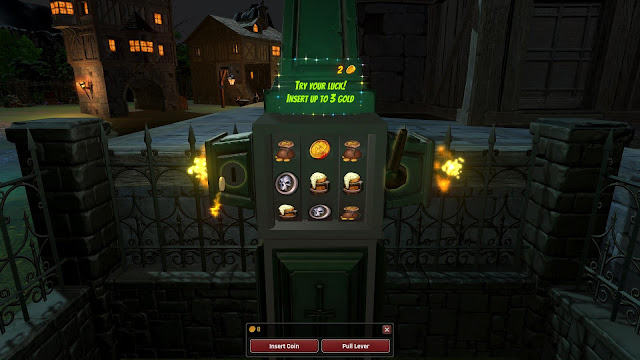 |
| Initially I only provided the UI at the bottom to interact with it, but when my wife played it she kept trying to interact with the coin slot and handle directly, so I made those interactive as well. It gives it a more tangible feel. |
Part of what I like about my theme is that it combines dark and gritty with silly and comical. You'll be walking through an ominous graveyard and then come across a dancing skeleton who gets a fright when he sees you. After leaving the graveyard you might stumble upon this bright flashing slot machine. It admittedly feels a bit incongruous but it does add a strange and unusual feel to it all.
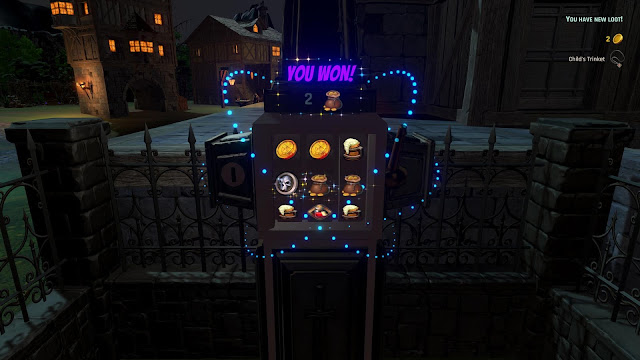 |
| You win rewards if you get 2 or 3 matches. The rewards are dependent on the icons matched. For example here there are 2 gold pouch matches, so the rewards are gold / treasure related. You can insert up to 3 coins, with more coins giving you more rewards. |
Reagent Harvesting
Reagents are ingredients that you harvest from certain plants that allow you to craft potions. To help you differentiate between reagent plants and general background plants, the ones that can be harvested are made more prominent using particle effects and lighting. Once you harvest them the special effects are disabled, making them blend into the background like ordinary plants.
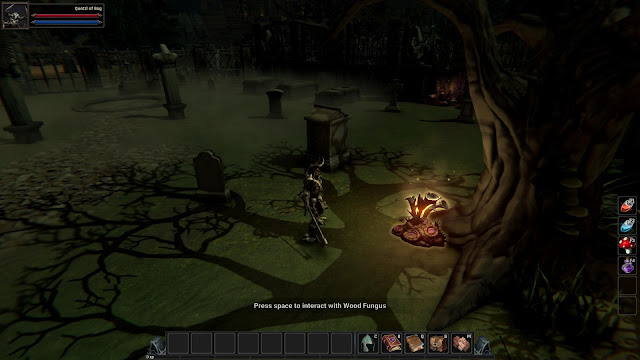 |
| The Crypt Lord has stumbled upon a wood fungus plant, which will allow him to harvest wood fungus to use at the potion cauldron later. |
Organ Harvesting Area
The organ harvesting area isn't an area where you actually harvest organs (I thought that would be a bit too disturbing, although I'm still open to the idea). It is a quest area where women and girls from the town have been captured. You need to discover what happened to them. You find them in cages and will eventually need to rescue them. Right now I've not actually implemented that part, so it feels quite gloomy because you see them and hear them crying but can't do anything about it.
The black market merchant you interact with in the town trades in organs, so it makes you wonder whether he is involved in this.
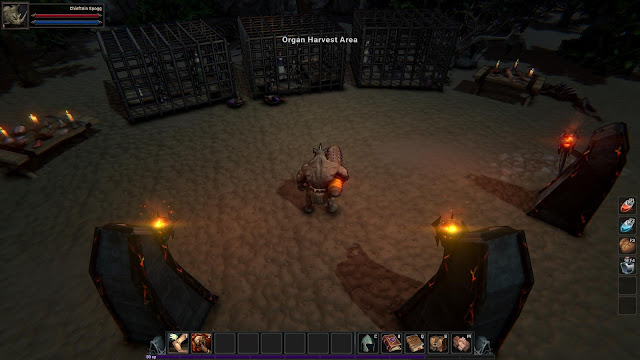 |
| The organ harvest area has women and girls trapped in cages, with tables containing various body parts nearby, hinting at their eventual fate. I put in a fair bit of detail though you can't see it here. There are food plates and urine buckets near the cages. I put in a lot of effort creating the haunting ambient sound effects of women weeping and pleading in despair. |
Potion Cauldron
The potion cauldron is where you craft potions using reagents you have collected. I have tried to make it very simple to use, while also trying to give it a tangible feel (as if you are actually interacting with a cauldron). It actually shows the ingredients dropping in and plays a rewarding sizzling sound and fancy liquid splash particle effects.
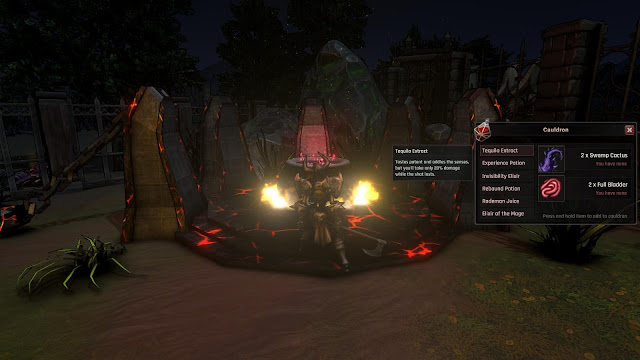 |
| In my initial pass you can only craft rare, special potions. These are quite valuable (whereas the ingredients you use to craft them aren't worth much by themselves), making it worth exploring this feature. However, in retrospect I think it may be a good idea to allow the player to craft simple health and mana potions too. |
Rune Forge Area
The rune forge area is not actually implemented yet, but it will be where you can use mined items (items like ore and crystals) to craft 'runes', which can be slotted onto armor and weapons to make them more powerful.
It's still a bit unclear to me exactly how this feature will work so I can't say much more about it right now. Hopefully it'll be splendid!
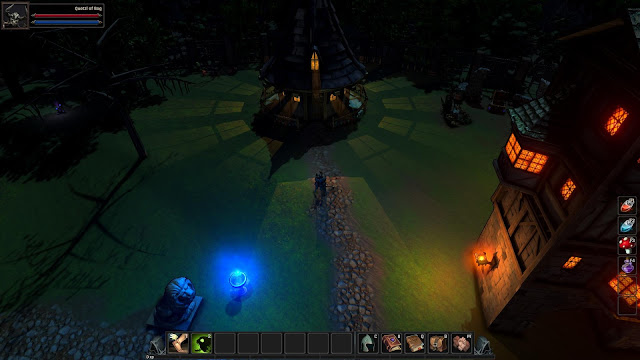 |
| The Crypt Lord standing outside the Rune Forge Area, wondering why the hell he can't actually do anything here yet. I provide several shadow quality options with the high quality options having most world lights flicker and cast shadows. The Rune Forge Area showcases this quite nicely. |
Lore Books
Lore books are one of the ways in which I expound upon the lore and history of the world. They are typically present near dungeon entrances to give some background information. Occasionally they are also present deep inside dungeons, telling stories about heroes and villains you'll encounter later.
An old friend, Matt Penney, offered to provide some voice acting, and I took up his offer for one of the lore books. I'm very happy with the results and am hoping he'll be amenable to providing more. Here is a link to the sample:
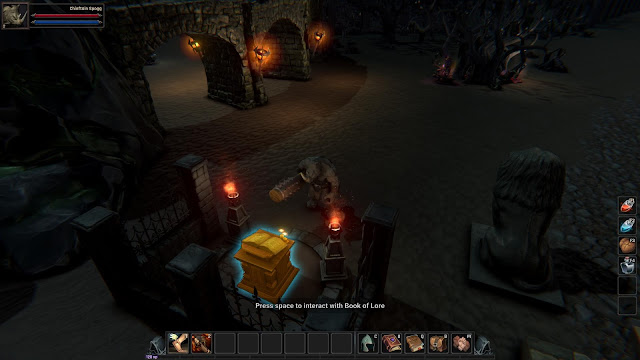 |
| This rhino fella is standing next to a lore book. |
Arcane Stones
These mysterious artifacts serve a purpose that not even I know yet. They'll probably give you some boon or buff. The reason I'm still undecided on what to do with them is that you already have so many skills, abilities, brews and potions that give you buffs. Yet another buff-giving item feels inconsequential, so I'm still mulling over it.
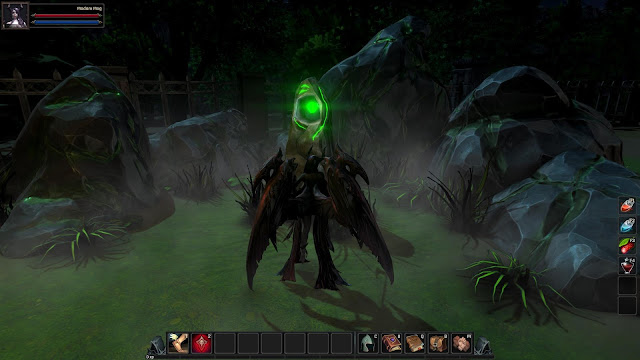 |
| What the heck does this thing even do? Not even I know. |
Abilities
I've divided character abilities into a set of shared abilities and class-specific abilities.
Shared abilities are things like 'dash' (which allows you to sprint for a while and navigate through the world more quickly) and 'illuminate' (which summons an orb of light to illuminate dark areas).
Class-specific abilities are obviously thematically related to the specific character. I've only got about one or two per class at the moment, and some of them are still works in progress.
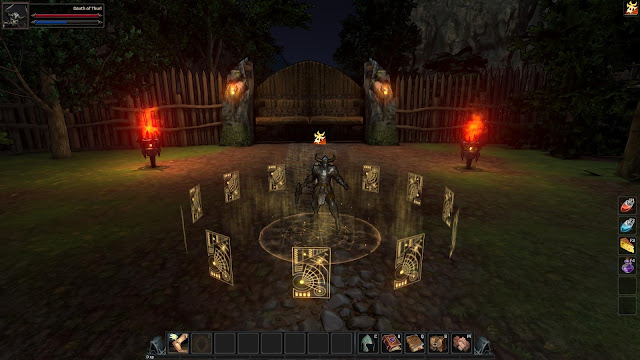 |
| The Dark Templar can summon the 'Shield of Ghaz'kar', which provides protection for him and any allies standing within it's sphere of influence. |
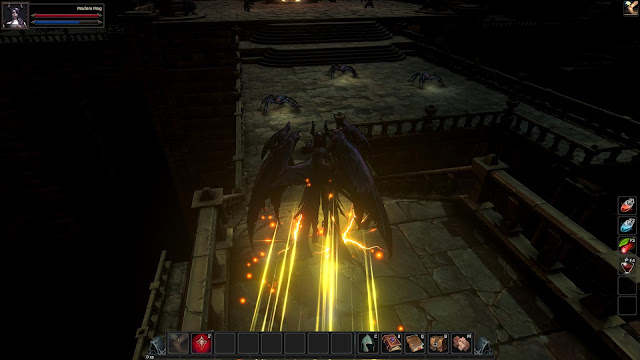 |
| The dash ability allows you to briefly sprint forward. It has a low mana cost and cooldown, so you can use it often if you're trying to move through an area quickly. It's also very useful for escaping hordes of enemies when you're about to die. |
Color Schemes
When showing the game to friends and colleagues I often get conflicting advice. Some want it more colorful, others advise making it grittier. Some like outlines, others don't. Some like intense bloom, others hate bloom and want it subtle to the point of almost not being present.
To deal with this nightmare I just chose to make all of these configurable via the graphics options. Outlines are optional, bloom intensity can be specified by the player, and there are several color schemes available (normal, grim and colorful).
 |
| This is the grim color scheme. It is high contrast, low saturation and has a sepia effect (yellowish color grading). This particular image may not have been the best demonstration since there is already a lot of orange and yellow present so it exaggerates the sepia a bit. |
Multiplayer Options
I started work on supporting multiplayer right from the start. It worked well at the time with the limited feature set present, but unfortunately, in trying to get the game fleshed out I've neglected it for a while. Nevertheless support for multiplayer features is somewhat present.
My initial intention was to have an MMO feel where you'd explore the town and other players would be exploring with you. I may still go this route, but if it proves too complex I may fall back to you exploring alone but then forming a raid party which invites other players to enter multiplayer mode to raid a dungeon together.
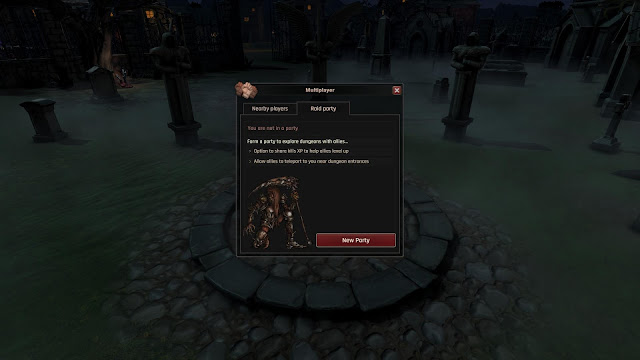 |
| The option to form a raid party is only partially implemented. One of the things I want to cater for is having experienced players assist newer players in leveling up. One of my frustrations with MMO's is that even if you want to play with friends, the experience gap is often too large and they're forced to create new low-level characters if they want to play with you. |

























